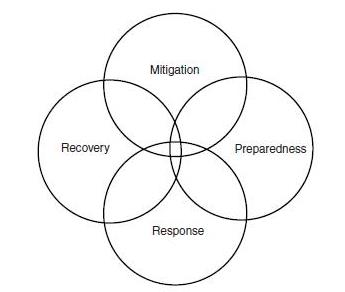By: Slobodan P. Simonovic
Reported by: Tarinee Thongcharoen (M1)
Part 1 / Management of Disasters: Chapter 2 / Integrated Disaster Management
Summary
Integrated disaster management is an iterative process of decision making regarding prevention of, response to, and recovery from, a disaster. This process provides a chance for those affected by a disaster to balance their diverse needs for protecting lives, property and the environment, and to consider how their cumulative disaster-related actions may affect long-term sustainability of the affected region. The disaster mitigation plan follows the disaster management cycle that has four integrated components: mitigation, preparedness, response, and recovery Figure 2.1 shows the Venn diagram presentation which introduced how to capture the idea of integrated disaster management where each component of the cycle has some overlapping activities with other components.
 Figure 2.1 The Venn diagram of integrated disaster management.
Figure 2.1 The Venn diagram of integrated disaster management.
1. Mitigation: Mitigation is long-term planning and it involves identifying the vulnerability of every part of the territory to particular types of hazards, and identification of steps that should be taken to minimize the risks. In the mitigation case, all partners in the integrated disaster management will determine what tools and personnel they will require, what training to offer, what outreach products must be prepared and distributed to the communities in the hazard-prone areas. The mitigation tools that have been proven to be the most useful for minimizing or redistributing losses and reducing social and economic disruption are land hazard mapping, adoption and enforcement of land use and zoning practices, implementing and enforcing building codes, flood plain mapping, reinforced tornado safe rooms, burying of electrical cables to prevent ice buildup, raising of homes in flood-prone areas, disaster mitigation public awareness programs, and insurance programs.
2. Preparedness: The purpose of preparedness is to anticipate problems in disasters so that ways can be devised to address the problems effectively and so that the resources needed for an effective response are in place beforehand. Preparedness includes activities as formulating, testing, and exercising disaster plans; providing training for disaster responders and the general public; and communicating with the public and others about disaster vulnerability and what to do to reduce it. Public must be educated about the nature of the hazards it faces and how to recognize and respond safely to them. It is important that the citizens become familiar with the way in which integrated disaster management and emergency services communicate information on severe weather.
3. Response: Disaster response activities include emergency sheltering, search and rescue, care of injured, firefighting damage assessment, and other emergency measures. The responders must also cope with response demands such as the need for coordination, communications, ongoing situation assessment, and resource mobilization during emergency period. The main challenge of emergency response is to overcome the natural tendency of all organizations involved to maintain their independence and autonomy during the emergency management.
4. Recovery: The basic meaning of recovery is putting a disaster-affected community back together. Its phases went all the way from temporary measures to restore community functions through replacement of capital stocks to pre disaster levels and returning the appearance of the community to normal to the final phase, which involved promoting future economic growth and development. The most recent view is that recovery is not just a physical outcome but a social process that encompasses decision making about restoration and reconstruction activities. Analyses of many disasters have demonstrated that there are patterns in the recovery process. Recovery is a set of actions that can be learned about and implemented accordingly. It is possible to anticipate some of the main concerns, problems, and issues during recovery and to plan for them as a part of mitigation phase.
One of the most important factors that influence integrated disaster management which will minimize loss of life, injury, and material damage is the decision-making process. Decision making is the process of making an informed choice among the alternative actions that are possible. The process may involve establishing objectives, gathering relevant information, identifying alternatives, setting criteria for the decision, and selecting the best option. For individual, people are typically unaware of the hazards they are exposed to. In general, people think about disaster in terms of usefulness, cost, time requirements, and protection implementation obstacles. There is a consensus that motivating people to take disaster-mitigative action is a process of overcoming social conformity and encouraging innovation. For organization, disaster management decisions are preceded by awareness of a hazard, awareness of alternative options, adoption of one or more options, implementation of the options adopted, and subsequent evaluation. For government, a variety of models exist to help understand natural hazard adoption and implementation by governments. Political science identifies behavioral models such as political systems theory, group theory, elite theory, institutionalism, and rational choice theory as available forms of government decision making. It is expected that federal, state, and local policymakers’ processing of disaster information is systematic. Integrated disaster management involves complex interactions within and between the natural environment, human population, and built environment. A different thinking is required to address the complexity of disaster management.
Reporter’s Own Thoughts
This chapter introduces us the basic ideas of integrated disaster management. I have only summarized the theory part which gave us the rough image about how the integrated disaster management works but for the clearer image the author also gave the example of the institutions in Canada such as the Federal Government whose act in at least one part of the Venn diagram.